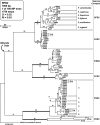Phylogenetic diversity and microsphere array-based genotyping of human pathogenic Fusaria, including isolates from the multistate contact lens-associated U.S. keratitis outbreaks of 2005 and 2006
- PMID: 17507522
- PMCID: PMC1933018
- DOI: 10.1128/JCM.00533-07
Phylogenetic diversity and microsphere array-based genotyping of human pathogenic Fusaria, including isolates from the multistate contact lens-associated U.S. keratitis outbreaks of 2005 and 2006
Abstract
In 2005 and 2006, outbreaks of Fusarium keratitis associated with soft contact lens use occurred in multiple U.S. states and Puerto Rico. A case-control study conducted by the Centers for Disease Control and Prevention (CDC) showed a significant association between infections and the use of one particular brand of lens solution. To characterize the full spectrum of the causal agents involved and their potential sources, partial DNA sequences from three loci (RPB2, EF-1alpha, and nuclear ribosomal rRNA) totaling 3.48 kb were obtained from 91 corneal and 100 isolates from the patient's environment (e.g., contact lens and lens cases). We also sequenced a 1.8-kb region encoding the RNA polymerase II second largest subunit (RPB2) from 126 additional pathogenic isolates to better understand how the keratitis outbreak isolates fit within the full phylogenetic spectrum of clinically important fusaria. These analyses resulted in the most robust phylogenetic framework for Fusarium to date. In addition, RPB2 nucleotide variation within a 72-isolate panel was used to design 34 allele-specific probes to identify representatives of all medically important species complexes and 10 of the most important human pathogenic Fusarium in a single-well diagnostic assay, using flow cytometry and fluorescent microsphere technology. The multilocus data revealed that one haplotype from each of the three most common species comprised 55% of CDC's corneal and environmental isolates and that the corneal isolates comprised 29 haplotypes distributed among 16 species. The high degree of phylogenetic diversity represented among the corneal isolates is consistent with multiple sources of contamination.
Figures

Similar articles
-
Use of multiple methods for genotyping Fusarium during an outbreak of contact lens associated fungal keratitis in Singapore.BMC Infect Dis. 2008 Jul 15;8:92. doi: 10.1186/1471-2334-8-92. BMC Infect Dis. 2008. PMID: 18627616 Free PMC article.
-
Multistate outbreak of Fusarium keratitis associated with use of a contact lens solution.JAMA. 2006 Aug 23;296(8):953-63. doi: 10.1001/jama.296.8.953. JAMA. 2006. PMID: 16926355
-
An outbreak of Fusarium keratitis associated with contact lens wear in Singapore.JAMA. 2006 Jun 28;295(24):2867-73. doi: 10.1001/jama.295.24.2867. JAMA. 2006. PMID: 16804153
-
Contact lens-related microbial keratitis: recent outbreaks.Curr Opin Ophthalmol. 2008 Jul;19(4):302-6. doi: 10.1097/ICU.0b013e3283045e74. Curr Opin Ophthalmol. 2008. PMID: 18545011 Review.
-
Fusarium keratitis and contact lens wear: facts and speculations.Med Mycol. 2008 Aug;46(5):397-410. doi: 10.1080/13693780801961352. Epub 2008 Apr 4. Med Mycol. 2008. PMID: 18608899 Review.
Cited by
-
Molecular phylogenetic diversity of dermatologic and other human pathogenic fusarial isolates from hospitals in northern and central Italy.J Clin Microbiol. 2010 Apr;48(4):1076-84. doi: 10.1128/JCM.01765-09. Epub 2010 Jan 27. J Clin Microbiol. 2010. PMID: 20107100 Free PMC article.
-
The mycorrhizal fungi of Cymbidium promote the growth of Dendrobiumofficinale by increasing environmental stress tolerance.PeerJ. 2021 Dec 6;9:e12555. doi: 10.7717/peerj.12555. eCollection 2021. PeerJ. 2021. PMID: 34963822 Free PMC article.
-
Multi-locus phylogeny and taxonomy of Exserohilum.Persoonia. 2018 Dec;41:71-108. doi: 10.3767/persoonia.2018.41.05. Epub 2018 Mar 13. Persoonia. 2018. PMID: 30728600 Free PMC article.
-
Removing chaos from confusion: assigning names to common human and animal pathogens in Neocosmospora.Persoonia. 2018 Dec;41:109-129. doi: 10.3767/persoonia.2018.41.06. Epub 2018 Apr 4. Persoonia. 2018. PMID: 30728601 Free PMC article.
-
Species-specific identification of a wide range of clinically relevant fungal pathogens by use of Luminex xMAP technology.J Clin Microbiol. 2009 Apr;47(4):1063-73. doi: 10.1128/JCM.01558-08. Epub 2009 Feb 25. J Clin Microbiol. 2009. PMID: 19244466 Free PMC article.
References
-
- Alfonso, E. C., J. Cantu-Dibildox, W. M. Munir, D. Miller, T. P. O'Brien, C. L. Karp, S. H. Yoo, R. K. Forster, W. W. Culbertson, K. Donaldson, J. Rodila, and Y. Lee. 2006. Insurgence of Fusarium keratitis associated with contact lens wear. Arch. Ophthalmol. 124:941-947. - PubMed
-
- Anaissie, E. J., R. T. Kuchar, J. H. Rex, A. Francesconi, M. Kasai, F.-M. Müller, M. Lozano-Chiu, R. C. Summerbell, M. C. Dignani, S. J. Chanock, and T. J. Walsh. 2001. Fusariosis associated with pathogenic Fusarium species colonization of a hospital water system: a new paradigm for the epidemiology of opportunistic mold infections. Clin. Infect. Dis. 33:1871-1878. - PubMed
-
- Bernal, M. D., N. R. Acharya, T. M. Lietman, E. C. Strauss, S. D. McLeod, and D. G. Hwang. 2006. Outbreak of Fusarium keratitis in soft contact lens wearers in San Francisco. Arch. Ophthalmol. 124:1051-1053. - PubMed
-
- Chang, D. C., G. B. Grant, K. O'Donnell, K. A. Wannemuehler, J. Noble-Wang, C. Y. Rao, L. M. Jacobson, C. S. Crowell, R. Sneed, F. M. T. Lewis, J. K. Schaffzin, M. Kainer, C. A. Genese, E. C. Alfonso, D. B. Jones, A. Srinivasan, S. K. Fridkin, and B. J. Park. 2006. A multistate outbreak of Fusarium keratitis associated with use of a new contact lens solution. JAMA 296:953-963. - PubMed
MeSH terms
LinkOut - more resources
Full Text Sources
Medical
Molecular Biology Databases

